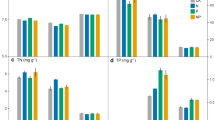Abstract
In New Zealand Hieracium is an opportunistic plant that invades high country sites more or less depleted of indigenous vegetation. To understand the invasive nature of this weed we assessed the changes in soil C, N and P, soil microbial biomass C, N and P contents, microbial C : N and C : P ratios, the metabolic quotient, and turnover of organic matter in soils beneath Hieracium and its adjacent herbfield resulting from the depletion of tussock vegetation. The amounts of soil organic C and total N were higher under Hieracium by 25 and 11%, respectively, compared to soil under herbfield. This change reflects an improvement in both the quantity and quality of organic matter input to mineral soil under Hieracium, with higher percentage organic C and a lower C : N ratio. The microbial biomass C, N and P contents were also higher under Hieracium. The amount of C respired during the 34-week incubation indicated differences in the nature of soil organic matter under Hieracium, the unvegetated "halo" zone surrounding Hieracium patches, and herbfield (depleted tussock grassland). Decomposition of organic matter in these zones showed that the Hieracium soil had the greatest rate of CO2 respired, and the halo soil had the lowest. We relate the enhanced organic C turnover to the invasive nature of Hieracium. Net N mineralization was significantly lower from the Hieracium soil (57 mg N g–1 soil N) than from herbfield and halo soils (74 and 71 mg N g–1 soil N, respectively), confirming that the nature of organic N in Hieracium soil is different from adjoining halo and herbfield soils. It seems plausible that specific compounds such as polyphenols and lignins released by Hieracium are not only responsible for increased organic N, but also control the form and amount of N released during organic matter transformations. We conclude that the key to the success of Hieracium in the N-deficient South Island high country of New Zealand lies in its ability to control and sequester N supply through modifying the soil organic matter cycle.
Similar content being viewed by others
Author information
Authors and Affiliations
Additional information
Received: 1 December 1998
Rights and permissions
About this article
Cite this article
Saggar, S., McIntosh, P., Hedley, C. et al. Changes in soil microbial biomass, metabolic quotient, and organic matter turnover under Hieracium (H. pilosella L.). Biol Fertil Soils 30, 232–238 (1999). https://doi.org/10.1007/s003740050613
Issue Date:
DOI: https://doi.org/10.1007/s003740050613




